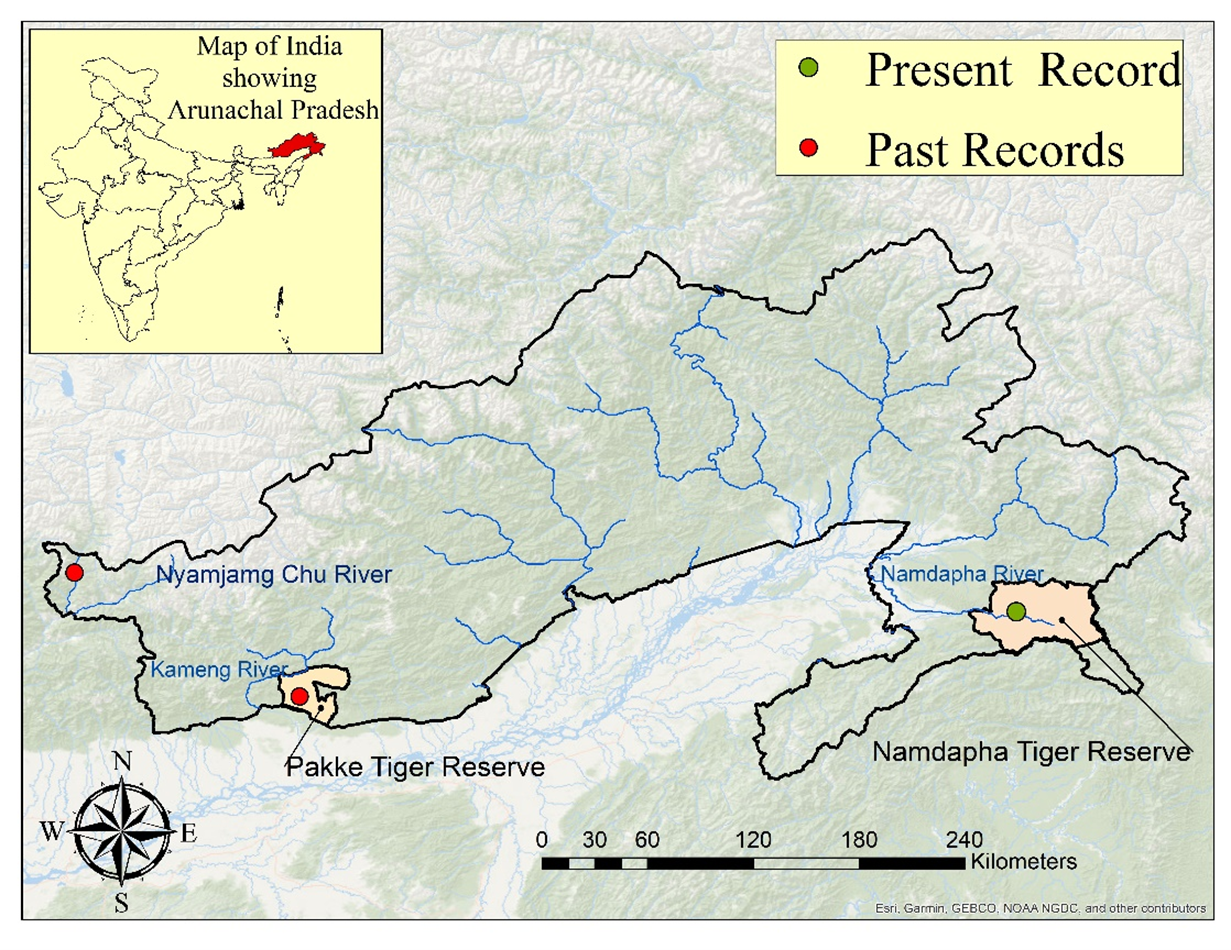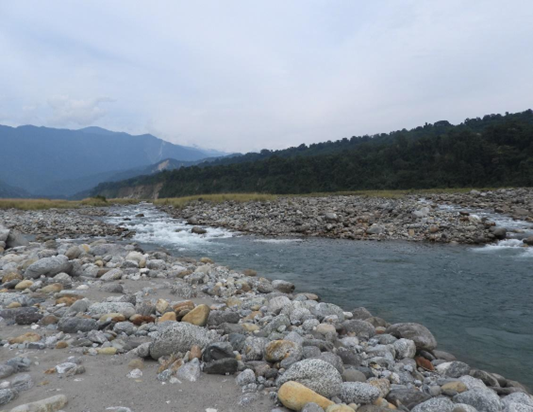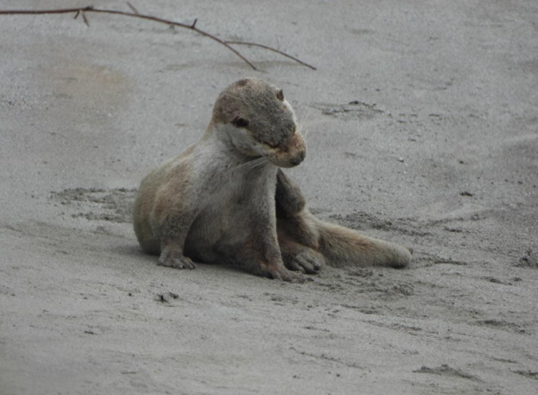IUCN/SSC Otter Specialist Group Bulletin

©IUCN/SCC Otter Specialist Group
Volume 42 Issue 1 (January 2025)
Citation: Bida, Y.B. and Rai, M. (2025). Photographic Record of Eurasian Otter (Lutra lutra) from Namdapha Tiger Reserve, Arunachal Pradesh, India. IUCN Otter Spec. Group Bull. 42 (1): 9 – 13
Photographic Record of Eurasian Otter (Lutra lutra) from Namdapha Tiger Reserve, Arunachal Pradesh, India.
Yumlam Benjamin Bida1,2 * and Manoj Rai1
1Ashoka Trust for Research in Ecology and the Environment, Regional Office Eastern Himalaya-Northeast India, NH 10, Tadong-737102, East Sikkim, India.
2North Eastern Regional Institute of Science and Technology (deemed to be University), Department of Forestry, Nirjuli-791109, Arunachal Pradesh, India
*Corresponding Author Email: benjamin.bida@atree.org
Received 6th August 2024, accepted 5th October 2024
Abstract: Eurasian otters (Lutra lutra) are classified as near threatened by the IUCN and listed under Appendix I of CITES. Despite their widespread distribution across India, documentation remains sparse. In Arunachal Pradesh, all three otter species - Eurasian otter (Lutra lutra), Smooth-coated otter (Lutrogale perspicillata), and Asian small-clawed otter (Aonyx cinereus) - are present, but information on their distribution is limited. Notably, Eurasian otter sightings in Arunachal Pradesh have primarily been from western regions. This study presents the first photographic evidence of a Eurasian otter in the eastern region of Arunachal Pradesh's Namdapha Tiger Reserve.
Keywords: Eurasian otter (lutra lutra), Namdapha Tiger Reserve, Eastern Arunachal Pradesh.
INTRODUCTION
Eurasian otters (Lutra lutra) are listed as Near Threatened by the IUCN and are under Appendix I of CITES (Loy et al., 2022). Although they are widely distributed across India, inhabiting a variety of habitat such as lakes, rivers, streams, rivers, swamps, coastal area and estuaries, their presence is poorly documented (North India - Pal et al., 2021, Jamwal et al., 2016; Central India - Jena et al., 2016, Joshi et al., 2016, Uikey, 2021, Suraj et al. 2022; Western Ghats- Mudappa et al., 2018; Eastern Ghats- Adhya and Dey, 2020; North-east India - Bhattacharya et al., 2019, Khatiwara and Bhutia, 2020, Borker et al., 2022). In Arunachal Pradesh, all three otter species -Eurasian otters, Smooth-coated otters, and Asian Small-clawed otters - have been documented (Borker et al., 2022). However, published information on their distribution is scarce. While Eurasian otters have been recorded in Arunachal Pradesh, most sightings are from the western parts of the state (Bhattacharya et al., 2019; Borker et al., 2022). The present sighting from Namdapha Tiger Reserve, therefore, marks the first photographic record from eastern Arunachal Pradesh (Fig. 1).
During the 2021-2024 monitoring season of the Critically Endangerd White-bellied Heron (Ardea insignis) in Namdapha Tiger Reserve (Fig. 2)., we encountered one Eurasian otter through direct sighting.
On October 24, 2023, a single Eurasian Otter was observed grooming itself for about 2 minutes, on a sandy patch on the bank of the Namdapha River (27° 31′N, 96° 30′E; WGS 84; 476 m elevation) (Fig. 3). After grooming, the otter basked, walked across the sandy area, and swam along the riverbank for approximately 4 meters before diving and disappearing from view. The otter was later seen hunting around 30 meters away from its sand basking spot, spending about 40 minutes searching for fish without success. It then swam across the river, walked into the vegetation and disappeared. The area of the river where the otter was sighted had a pond-like appearance, while the section where it hunted was more riffled. This river stretch had an average riverbed width of 33.3 meters, an average river width of 20 meters, and an average depth of 28.3 cm.
Otters serve as excellent indicators of healthy riverine ecosystems (Madsen et al., 2001). However, their populations are declining due to habitat degradation and poaching (Savage, 2022). The Himalayas, with their extensive river drainage systems, offer potential habitats for otters. However, unprecedented intensive developmental activities in the Himalayas poses a significant threat to both the habitat and the species. This, coupled with the lack of information about their distribution, could be a major drawback in conservation efforts. Consequently, more otter-specific studies are necessary to understand their distribution and status, which is essential for effective conservation.
Acknowledgments - We thank staff at ATREE, Regional Office Eastern Himalaya-Northeast India for various support: Dr. Sarala Khaling, Mr. Rohit George, Mr. Sunil Dahal. We thank Dr. Sailendra Dewan for preparing the map. We extend our gratitude towards Department of Forest, and Government of Arunachal Pradesh for the permit (Permit No. CWL/Gen/2018-19/Pt.X/1516-20) to work in NTR. The staff of Namdapha Tiger Reserve are acknowledged for their support and co-operation. Financial support for fieldwork was provided by The Habitat Trust as part of the project: Saving the White-bellied Heron in Arunachal Pradesh, India.
REFERENCES
Adhya, T., Dey P. (2020). First record of Eurasian otter (Lutra lutra) from Chilika lagoon: A Ramsar Site situated on the East Coast of India. OTTER, Journal of the International Otter Survival Fund. 6: 49 – 55. https://www.otter.org/s/Volume-6.pdf
Bhattacharya, M., Watham, T., Gopi, G.V. (2019). Photographic Records of Eurasian Otter (Lutra lutra Linnaeus, 1758) from Nyamjang Chu River, Arunachal Pradesh, India. IUCN Otter Spec. Group Bull. 36 (2): 103 – 109. https://www.iucnosgbull.org/Volume36/Bhattacharya_et_al_2019.html
Borker, A., Gogi, K., Krupa, H., Savage, M., Bhardwaj, N. (2022). Otter Survey in Pakke Tiger Reserve, Arunachal Pradesh, Eastern Himalayas of India. IUCN Otter Spec. Group Bull. 39 (1): 29 – 38. https://www.iucnosgbull.org/Volume39/Borker_et_al_2022.html
Jamwal, P.S., Takpa, J., Chandan, P., Savage, M. (2016). First Systematic Survey for Otter (Lutra lutra) in Ladakh, Indian Trans Himalayas. IUCN Otter Spec. Group Bull. 33 (1): 79 – 85. https://www.iucnosgbull.org/Volume33/Jamwal_et_al_2016.html
Jena, J., Bhargava, D., Borah, J., Dey, S. (2016). Notes on the Occurrence of the Eurasian Otter (Lutra lutra L.) in the Forest of Balaghat, Madhya Pradesh, India. IUCN Otter Spec. Group Bull. 33 (2): 59 – 63. https://www.iucnosgbull.org/Volume33/Jena_et_al_2016.html
Joshi, A.S., Tumsare, V.M., Nagar, A.K., Mishra, A.K., Pariwakam, M.P. (2016). Photographic Records of Eurasian Otter Lutra lutra from the Central Indian Landscape. IUCN Otter Spec. Group Bull. 33 (1): 73 – 78. https://www.iucnosgbull.org/Volume33/Joshi_et_al_2016.html
Khatiwara, S. and Bhutia, K.C. (2020). A Distribution Survey for Otters in Sikkim, India. IUCN Otter Spec. Group Bull. 37 (4): 212 – 218. https://www.iucnosgbull.org/Volume37/Khatiwara_Bhutia_2020.html
Loy, A., Kranz, A., Oleynikov, A., Roos, A., Savage, M. & Duplaix, N. (2022). Lutra lutra (amended version of 2021 assessment). The IUCN Red List of Threatened Species 2022: e.T12419A218069689.
https://dx.doi.org/10.2305/IUCN.UK.2022-2.RLTS.T12419A218069689.en
Madsen, A.B., Prang, A. (2001). Habitat factors and the presence or absence of otters Lutra lutra in Denmark. Acta Theriol. 46: 171–179. https://doi.org/10.1007/BF03192426
Mudappa, D., Prakash, N., Pawar, P., Srinivasan, K., Ram, M.S., Kittur, S., Umapathy, G. (2018). First Record of Eurasian Otter Lutra lutra in the Anamalai Hills, Southern Western Ghats, India. IUCN Otter Spec. Group Bull. 35 (1): 47 – 56. https://www.iucnosgbull.org/Volume35/Mudappa_et_al_2018.html
Pal, R., Sharma, A., Dubey, V.K., Bhattacharya, T., Jhonson, J.A., Sivakumar, K., Sathyakumar, S. (2021). A rare photographic record of Eurasian Otter Lutra lutra with a note on its habitat from the Bhagirathi Basin, western Himalaya, India. Journal of Threatened Taxa, 13 (13): 20072-20077. https://doi.org/10.11609/jott.6937.13.13.20072-20077
Savage, M. (2022). Otters in Northeast India: A Review of the Sparse Available Information. IUCN Otter Spec. Group Bull. 39 (2): 81 – 89.
https://www.iucnosgbull.org/Volume39/Savage_2022.html
Suraj, M., Ahmed, M., Basak, K., Sarathi, J., Pandey, P., Khelwar, A. (2022). First Record of Eurasian Otter (Lutra lutra) from Chhattisgarh, Central India. IUCN Otter Spec. Group Bull. 39 (4): 229 - 235. https://www.iucnosgbull.org/Volume39/Suraj_et_al_2022.html
Uikey, S.K. (2021). First Photographic Record of Eurasian Otter (Lutra Lutra) from Kanha National Park (M.P.) India. International Journal of Innovative Research and Advanced Studies. 8 (9): 7-9. https://www.ijiras.com/2021/Vol_8-Issue_9/paper_2.pdf
Résumé: Enregistrement Photographique de la Loutre Eurasienne (Lutra lutra) de la Réserve des Tigres de Namdapha, dans l’Arunachal Pradesh, en Inde
Les loutres d’Eurasie (Lutra lutra) sont considérées comme quasi menacées par l’UICN et inscrites à l’Annexe I de la CITES. Malgré leur large répartition en Inde, l’information reste limitée. Dans l’Arunachal Pradesh, les trois espèces de loutres - la loutre d’Eurasie (Lutra lutra), la loutre à pelage lisse (Lutrogale perspicillata) et la loutre cendrée (Aonyx cinereus) - sont présentes, mais les informations sur leur répartition sont rares. Il convient de noter que les observations de loutres d’Eurasie dans l'Arunachal Pradesh ont principalement eu lieu dans les régions occidentales. Cette étude présente la première preuve photographique d’une loutre d’Eurasie dans la région orientale de la Réserve des Tigres de Namdapha dans l’Arunachal Pradesh.
Revenez au dessus
Resumen: Registro Fotográfico de Nutria Eurasiática (Lutra lutra) en la Reserva de Tigres Namdapha, Arunachal Pradesh, India
Las nutrias Eurasiáticas (Lutra lutra) están clasificadas como casi amenazadas por la UICN, y están listadas en el Apéndice I del CITES. A pesar de su amplia distribución en India, la documentación permanece escasa. En Arunachal Pradesh están presentes las tres especies de nutria -nutrias Eurasiáticas (Lutra lutra), nutrias Lisas (Lutrogale perspicillata) y nutrias de uñas pequeñas Asiáticas (Aonyx cinereus), pero la información sobre las respectivas distribuciones es limitada. En forma notable, los avistajes de nutria Eurasiática en Arunachal Pradesh han ocurrido primariamente en las regiones ocdidentales. Este estudio presenta la primer evidencia fotográfica de una nutria Eurasiática en la región oriental de la Reserva de Tigres Namdapha, Arunachal Pradesh.
Vuelva a la tapa




